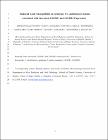| dc.contributor.author | SULLIVAN, DEREK | en |
| dc.date.accessioned | 2007-03-06T19:07:44Z | |
| dc.date.available | 2007-03-06T19:07:44Z | |
| dc.date.issued | 2005 | en |
| dc.date.submitted | 2005 | en |
| dc.identifier | 13583 | en |
| dc.identifier.citation | Pinjon, E., Jackson, C.J., Kelly, S.L., Sanglard, D., Moran, G., Coleman, D.C. and Sullivan, D.J., Reduced azole susceptibility in genotype 3 C. dubliniensis isolates associated with increased CdCDR1 and CdCDR2 expression., Antimicrobial Agents and Chemotherapy., 49, 4, 2005, 1312, 1318 | en |
| dc.identifier.other | Y | en |
| dc.identifier.other | Y | en |
| dc.identifier.uri | http://hdl.handle.net/2262/6098 | |
| dc.description | PUBLISHED | en |
| dc.description.abstract | Candida dubliniensis is a recently identified yeast species primarily associated with oral carriage and infection in HIV-infected individuals. The species can be divided into at least four
genotypes on the basis of the nucleotide sequence of the ITS region of the rRNA operon.
Previous studies have shown that a small number of clinical isolates belonging to genotype 1 are resistant to the commonly used antifungal drug fluconazole. The aim of the present study was to investigate the molecular mechanisms responsible for reduced susceptibility to azole drugs in C. dubliniensis genotype 3 isolates obtained from a patient with fluconazole-recalcitrant oral candidiasis. Four isolates from a single clinical sample, one susceptible, the other three exhibiting reduced susceptibility to fluconazole, itraconazole, ketoconazole, voriconazole and posaconazole, were examined. Results showed that reduced susceptibility to azole drugs was associated with an increase in the expression of the multidrug transporters CdCDR1 and CdCDR2 which correlated with reduced intracellular accumulation of radiolabeled fluconazole and an increase in energy-dependent efflux mechanisms. In contrast to observations made in previous studies, overexpression of the multidrug transporter CdMDR1 was not observed. Despite a thorough investigation of all commonly encountered mechanisms of azole resistance, no other mechanism could be associated with reduced susceptibility to azole drugs in the clinical isolates studied. This is the first report of CdCDR2 involvement in azole resistance in C. dubliniensis. | en |
| dc.format.extent | 1368352 bytes | |
| dc.format.extent | 1312 | en |
| dc.format.extent | 1318 | en |
| dc.format.mimetype | application/pdf | |
| dc.language.iso | en | en |
| dc.relation.ispartofseries | 49 | en |
| dc.relation.ispartofseries | 4 | en |
| dc.relation.ispartofseries | Antimicrobial Agents and Chemotherapy. | en |
| dc.rights | Y | en |
| dc.subject | Candida dubliniensis | en |
| dc.subject | Genotype 3 | en |
| dc.subject | Azole resistance | en |
| dc.subject | CdCDR1 | en |
| dc.subject | CdCDR2 | en |
| dc.title | Reduced azole susceptibility in genotype 3 C. dubliniensis isolates associated with increased CdCDR1 and CdCDR2 expression. | en |
| dc.title.alternative | Increased CdCDR1 and CdCDR2 expression in C. dubliniensis | en |
| dc.type | Journal Article | en |
| dc.type.supercollection | scholarly_publications | en |
| dc.type.supercollection | refereed_publications | en |
| dc.identifier.peoplefinderurl | http://people.tcd.ie/djsullvn | en |
| dc.identifier.rssinternalid | 13583 | en |
| dc.identifier.rssuri | http://gateway.isiknowledge.com/gateway/Gateway.cgi?&GWVersion=2&SrcAuth=CustomerName&SrcApp=CustomerName&DestLinkType=FullRecord&KeyUT=000228082500007&DestApp=WOS | en |
| dc.contributor.sponsor | Health Research Board | |




